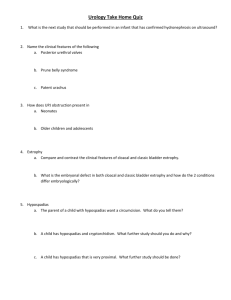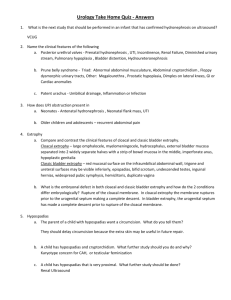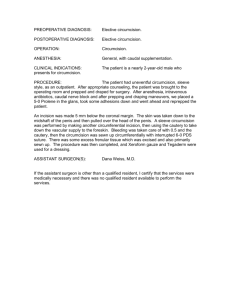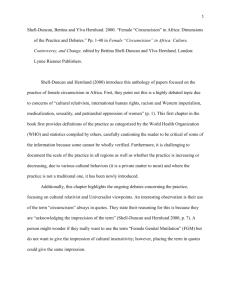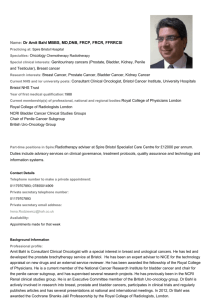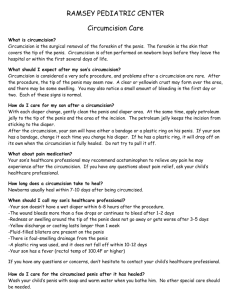Cutaneous Urinary Diversion: Pyelostomy & Ureterostomy
advertisement
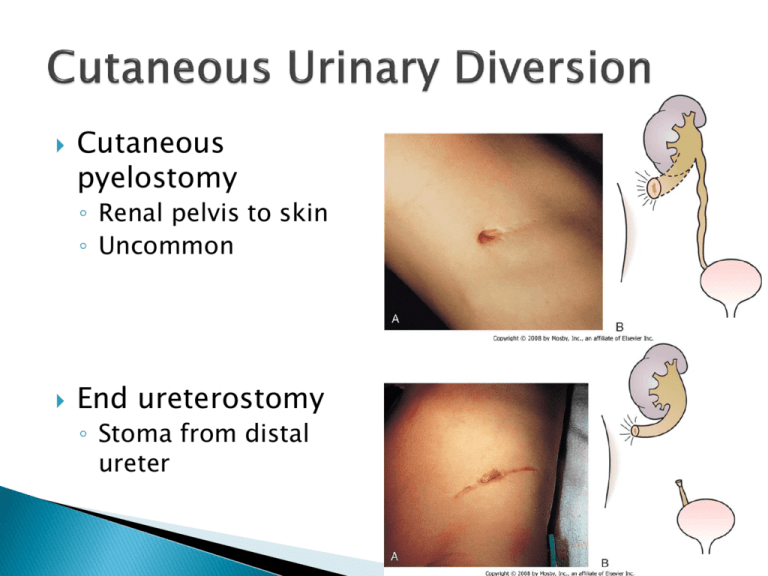
Cutaneous pyelostomy ◦ Renal pelvis to skin ◦ Uncommon End ureterostomy ◦ Stoma from distal ureter Loop ureterostomy ◦ Double barrel ◦ Proximal and distal ureter Intestinal diversion ◦ Bowel between skin and ureters Cutaneous Vesicostomy ◦ Most common ◦ Bladder to skin Appendicovesicostomy ◦ Continent ◦ Intermittent cath Nephrostomy ◦ Catheter from upper urinary tract to skin You are called to the delivery room to evaluate a female baby with this defect which is located on the lower anterior abdominal wall. What is the most likely diagnosis? A. B. C. D. E. Myelomeningocele Cloacal extrophy Hindgut extrophy Prune belly syndrome Classic bladder extrophy Cloacal Extrophy ◦ 1/200,000 ◦ Rupture of cloacal membrane Before urorectal septum completes descent to separate hindgut from bladder ◦ Prognosis Long-term survival 50% Cloacal Extrophy ◦ Exam Bladder 2 widely separate halves Bowel mucosa in the middle Ileocecal segment Imperforate anus Hypoplastic genitalia ◦ Associated findings Omphalocele Myelomeningocele Hydrocephalus Classic Extrophy ◦ 1/40,000 ◦ More common in boys ◦ Premature rupture of the cloacal membrane ◦ Exam Red mucosal surface Infraumbilical abdominal wall Bladder as an open book Inferior aspect ureteral orifices Classic Extrophy ◦ Exam Epispadias Bifid or rudimentary penis Normal or bifid scrotum Inguinal hernias Widespread pubic symphysis Hemiclitoris Duplicate vagina Classic Extrophy ◦ Treatment Keep bladder surface moist Examine upper tract Neonatal closure Pelvic osteotomy Epispadias ◦ 55% boys Penopubic Widened pubic symphysis Broad spade-like penis Urethra opened fully on dorsal surface to bladder neck Dorsally tethered penis Incontinent ◦ Other boys Penile or balanitic epispadias Normal continence Epispadias ◦ Girls Rare Incontinence Wide urethra Bifid clitoris ◦ Treatment Genitoplasty Staged surgical correction Renal U/S and VCUG Acute ◦ Usually voluntary ◦ Associated with Severe acute cystitis Urethritis Meatitis Vaginitis ◦ Other causes Boys Urethral stricture Meatal stenosis with meatitis Girls Ureterocele Other causes ◦ Both Bladder or urethral calculi Masses - compression Pelvic masses Rhabdomyosarcoma Uterine or ovarian masses Hydro or hydrometrocolpos Sacrococcygeal tumors Constipation Involvement of nerve roots Spinal cord injury, tumor or transverse myelitis Congenital Meningocele Myelomeningocele Intradural lipoma Diastematomyelia Sacral agenesis Acquired Trauma Transverse myelitis Spinal cord tumor Goals of management ◦ Preserve renal function ◦ Prevent renal damage from infection ◦ Provide social continence Evaluation ◦ Radiographic or urodynamics ◦ Several times in first year Yearly thereafter Warning signs ◦ Infection ◦ Fever ◦ Change in continence AKA Hinman-Allen syndrome Dysfunctional voiding ◦ Features Day and night incontinence Fecal soiling UTI Behavioral problems Detrusor/sphincter discoordination ◦ Consequences Incontinence Renal failure Dysfunctional voiding ◦ Diagnosis of exclusion ◦ Must rule out Tethered spinal cord Infravesical obstruction ◦ Treatment Bladder retraining Timed regimen Biofeedback Intermittent cath Reverse complications Temporary diversion Renal function Behavioral or psychological therapy The parents of a newborn male with the pictured physical exam finding inquire about circumcision. What do you tell them? A. B. C. D. E. With their consent, you will proceed with circumcision You will call the urologist and have him do the circumcision Since they are medicaid, you will not perform the circumcision since it is no longer covered Circumcision should be delayed in case the skin is needed for reconstruction The patient needs immediate repair Hypospadias ◦ 1/250 males ◦ Location of meatus Glanular Coronal Subcoronal Distal shaft Midshaft Proximal shaft Penoscrotal Scrotal Perineal ◦ ? Chordee Hypospadias ◦ Further work up Cryptorchidism also? Karyotype VCUG? Only with severe lesions or UTI Renal U/S? Proximal lesions ◦ Treatment Delay circumcision Repair at 6 months Chordee ◦ Ventral penile curvature ◦ Uncommon without hypospadias ◦ 3 possibilities Skin tethering Abnormal development of urethra and ventral penile structures Congenitally short urethra ◦ Treatment Depends on cause Delay circumcision Penile Torsion ◦ Congenital or acquired ◦ Most commonly mild ◦ Median raphe spirals around shaft Counterclockwise ◦ May be seen after circumcision or hypospadias repair Webbed penis ◦ Cosmetic ◦ Transposition of scrotal skin onto the ventral penile shaft at the penoscrotal junction Buried penis ◦ Most common after circumcision ◦ Result of thick suprapubic fat pad ◦ Resolves with normal development ◦ Severe cases may require surgery Meatal Stenosis ◦ Dysuria, strangury, deflected stream ◦ Need to observe stream Examination insufficient ◦ Meatotomy under local anesthesia is curative Meatal Bridge ◦ Results from meatal stenosis in which ventral aspect recanalizes Preputial adhesions and skin bridges ◦ Fibrinous adhesions Incomplete retraction of prepuce in normal development Post-Circumcision ◦ Complications Disfiguring Recurrent inflammation and infection Trapped smegma ◦ Surgical correction is complicated Which of the following is the most accurate definition of micropenis in an infant? ◦ ◦ ◦ ◦ A Penile B Penile C Penile D Penile stretch length <2cm stretch length <1cm length <2cm (not-stretched) length <0.5cm (not-stretched) Stretch length <2cm (2 S.D. below mean) 2 Causes ◦ Hypogonadotropic hypogonadism (Failure of hypothalamus to produce GnRH) ◦ Primary testicular failure Deficient testosterone production Requires extensive workup ◦ Include karyotype, ?MRI of brain? 3 month trial of testosterone Usually associated with severe deformities of lower urinary tract and genitalia Complete evaluation of upper and lower tract
